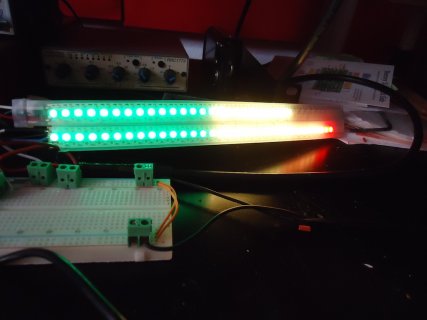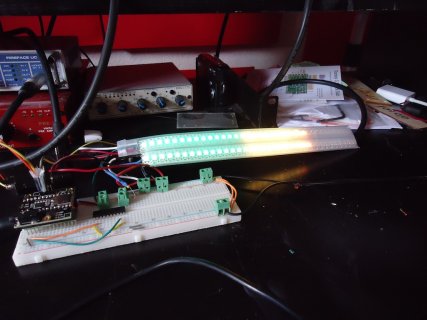nicolas_soundforce
Active member
Hi there,
For my second teensy project I went for a Audio Meter for my home studio.
I got a Teensy 3.1 and the audio adapter, soldered 2 jacks and plugged them on 2 audio outputs on my audio interface.
Using my interface software/mixer I route the signal I want to meter to the teensy.
Using 2 x 1/4th of 1m of Adafruit 144 ledstrips, I got left and right channels meter.
Between the signal pins and the led strips I wired a 74HCT245N. It's NOT working without it.
There was a resistor already included at the left side of the strip so I just add to add a 470 Ohms resistor on the right channel led strip.
And a cap between the + and - pins of the power supply to protect the strips.
The whole project (teensy included) is powered via a 5v 2a power supply.
Here is the project in action, the poor video quality does make justice to the speed of the meter :
I took the StereoPeakMeter example as a starting point. I found there the functions peak_L and peak_L.
I am using those but I am not sure how they really work.
For the LED strips I decided to try to the FastLED library as I read that the OctoWS2811 library was not working properly along the audio board. I used pins 0 and 1 for the led strips signal pins.
THE CODE is below.
Paul if you read this, would you mind explaining a bit the working of the function ? I can't find any documentation on this.
Also I saw that maximum value coming of the ADC is about 65000. Is it possible to make a correlation between audio line level signals and the ADC returning values ? I would like to make this meter as accurate as possible.
At the moment I sent sine waves at different audio levels (from -28db to 0db) from the computer to the teensy/audio board and measured the resulting ADC value. I took one calibration value per LED.
I am not sure if I should use the Peak function ?! I just want to take a sample of the incoming audio and lights the right LED according to the level.
Can I just read the line level inputs with an easy function ?
Paul, I love the teensy thank you so much for it.
Gr,
Nicolas.




For my second teensy project I went for a Audio Meter for my home studio.
I got a Teensy 3.1 and the audio adapter, soldered 2 jacks and plugged them on 2 audio outputs on my audio interface.
Using my interface software/mixer I route the signal I want to meter to the teensy.
Using 2 x 1/4th of 1m of Adafruit 144 ledstrips, I got left and right channels meter.
Between the signal pins and the led strips I wired a 74HCT245N. It's NOT working without it.
There was a resistor already included at the left side of the strip so I just add to add a 470 Ohms resistor on the right channel led strip.
And a cap between the + and - pins of the power supply to protect the strips.
The whole project (teensy included) is powered via a 5v 2a power supply.
Here is the project in action, the poor video quality does make justice to the speed of the meter :
I took the StereoPeakMeter example as a starting point. I found there the functions peak_L and peak_L.
I am using those but I am not sure how they really work.
For the LED strips I decided to try to the FastLED library as I read that the OctoWS2811 library was not working properly along the audio board. I used pins 0 and 1 for the led strips signal pins.
THE CODE is below.
Paul if you read this, would you mind explaining a bit the working of the function ? I can't find any documentation on this.
Also I saw that maximum value coming of the ADC is about 65000. Is it possible to make a correlation between audio line level signals and the ADC returning values ? I would like to make this meter as accurate as possible.
At the moment I sent sine waves at different audio levels (from -28db to 0db) from the computer to the teensy/audio board and measured the resulting ADC value. I took one calibration value per LED.
I am not sure if I should use the Peak function ?! I just want to take a sample of the incoming audio and lights the right LED according to the level.
Can I just read the line level inputs with an easy function ?
Paul, I love the teensy thank you so much for it.
Gr,
Nicolas.




Code:
// SoundForce - MTR
// 2014
// Nicolas Toussaint - http://sound-force.nl/
#include <Audio.h>
#include <Wire.h>
#include <SD.h>
#include <FastLED.h>
#define NUM_LEDS_PER_STRIP 36 //I used Adafruit 144 led strip and 1/4 meter pieces, so 36 LEDs per piece/chann
CRGB ledsA[NUM_LEDS_PER_STRIP]; //Left channel LED strip
CRGB ledsB[NUM_LEDS_PER_STRIP]; //Right channel LED strip
const int myInput = AUDIO_INPUT_LINEIN;
AudioInputI2S audioInput; // audio shield: mic or line-in
AudioPeak peak_L;
AudioPeak peak_R;
AudioOutputI2S audioOutput; // audio shield: headphones & line-out
AudioConnection c1(audioInput,0,peak_L,0);
AudioConnection c2(audioInput,1,peak_R,0);
AudioControlSGTL5000 audioShield;
// Calibration for the 36 leds, measured sending a test signal at different audio levels
int valueADC[37]= {
-2395, //0
-1320, //1
195, //2
2335, //3
5365, //4
13625, //5
15665, //6
17145, //7
19000, //8
21015, //9
22875, //10
25215, //11
27755, //12
30095, //13
33045, //14
36245, //15
37195, //16
38185, //17
39185, //18
40215, //19
41275, //20
42355, //21
43455, //22
44575, //23
45745, //24
46915, //25
48125, //26
49365, //27
50635, //28
51935, //29
53265, //30
54615, //31
56015, //32
57465, //33
58888, //34
60345, //35
100000000 //36
} ;
//Integer to store Left and Right channels level values
int ReadingL=0;
int ReadingR=0;
void setup() {
AudioMemory(6);
audioShield.enable();
audioShield.inputSelect(myInput);
audioShield.volume(0.75);
audioShield.unmuteLineout();
Serial.begin(Serial.baud());
FastLED.addLeds<NEOPIXEL, 0>(ledsA, NUM_LEDS_PER_STRIP); // Left channel LED STRIP
FastLED.addLeds<NEOPIXEL, 1>(ledsB, NUM_LEDS_PER_STRIP); // Right channel LED STRIP
LEDS.setBrightness(40); //Dimming the LEDs
}
elapsedMillis timer;
int SamplingPeriod = 45;
void loop() {
//Reading a sampling every sampling period for both channels
if (timer>SamplingPeriod){
timer=0;
ReadingL = peak_L.Dpp() - 5000;
ReadingR = peak_R.Dpp() - 5000;
peak_L.begin();
peak_R.begin();
}
//LEFT CHANNEL
//Turns off every LEDs when input is under lowest level
if ((ReadingL<valueADC[0])){
for (int i=0 ; i<36; i++){
ledsA[i] = CRGB::Black;
}
}
//Turns on and off LEDs according to calibration values
// 4 colors : Green/Yellow/Orange/red
for (int j =0; j<37; j++){
if ((ReadingL>valueADC[j]) && (ReadingL<valueADC[j+1])){
for (int i=0; i<j+1; i++){
if (i<15){
ledsA[i] = CRGB::Green;
}
if (i>=15 && i<25){
ledsA[i] = CRGB::Yellow;
}
if (i>=25 && i<31){
ledsA[i] = CRGB::Orange;
}
if (i>=31 && i<36){
ledsA[i] = CRGB::Red;
}
}
for (int k=j+1; k<36; k++){
ledsA[k] = CRGB::Black;
}
}
}
//RIGHT CHANNEL
//Turns off every LEDs when input is under lowest level
if ((ReadingR<valueADC[0])){
for (int i=0 ; i<36; i++){
ledsB[i] = CRGB::Black;
}
}
//Turns on and off LEDs according to calibration values
// 4 colors : Green/Yellow/Orange/red
for (int j =0; j<37; j++){
if ((ReadingR>valueADC[j]) && (ReadingR<valueADC[j+1])){
for (int i=0; i<j+1; i++){
if (i<15){
ledsB[i] = CRGB::Green;
}
if (i>=15 && i<25){
ledsB[i] = CRGB::Yellow;
}
if (i>=25 && i<31){
ledsB[i] = CRGB::Orange;
}
if (i>=31 && i<36){
ledsB[i] = CRGB::Red;
}
}
for (int k=j+1; k<36; k++){
ledsB[k] = CRGB::Black;
}
}
}
FastLED.show();
}
Last edited:

